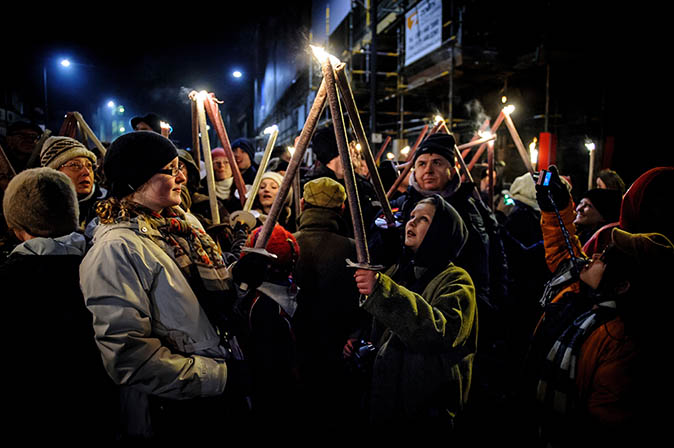Curious Questions: Why is New Year called 'Hogmanay' in Scotland?
For as long as anyone can remember, New Year – Hogmanay – has been a bigger deal to those living north of Anglo-Scottish border. Jason Goodwin explains why, and takes a look at the curious origins of this name.

I learned the elementary rules of surviving Hogmanay in a castle perched high on a bluff overlooking the gelid waters of the North Sea. It was New Year’s Day.
Hogmanay, as everyone knows, is a New Year’s revel, encapsulated in a word that fuses elements of cottage and war-cry, of homeliness and wildness, with no origin or meaning that anyone can reasonably define. Perhaps it’s old Gaelic or old French or Norse. Nobody, significantly, can remember.
That hasn’t stopped dictionaries from attempting to pin it down. ‘Early 17th century: perhaps from hoguinané, Norman French form of Old French aguillanneuf, meaning last day of the year, new year's gift,’ reads the entry at oxforddictionaries.com. Macmillan’s etymology blog concurs, suggesting that this definition ‘makes perfect sense in view of the auld alliance, the traditional alliance between the kingdoms of France and Scotland before the latter became joined to England through the ascension of King James VI of Scotland to the English throne as James I in 1603.’
The OED, however, also suggests that there is an earlier Latin predecessor in the world hagnonayse, first recorded almost two centuries earlier in 1443. To add to the confusion, some sources believe there is a Gaelic derivation from haugmenn, the Icelandic word for ‘hill-men’, or elves, banishing trolls into the sea. And the BBC’s researchers throw in a different etymology entirely, citing a Norse word ‘hoggo-nott', meaning Yule.
"Hogmanay does take to itself many of the more fiery and festive elements of Christmas, which the Presbyterians refused to celebrate because it wasn’t in the Bible – Christmas Day only became a national holiday in Scotland in 1958"
Given all these different accounts, let’s turn to Country Life’s editorial from 31 December 1898 instead for a pronouncement which we might as well decide is definitive: ‘if they [the etymologists] would forsake their books and consult the great heart of the people, they would find it to be a synonym for whisky.’
Defining Hogmanay is one thing. But surviving it? That’s a different matter entirely. That day in the castle everything started smoothly. We were whisked off the night train by our kindly hosts through a wonderland of frosted hedgerows, to be fed with ham and chocolate and entertained with views of the rolling sea.
The place was a hubbub of activity, preparing for the great Hogmanay dance that would stamp out the old year and trip in the new: there were telephone calls and people shooting off on bicycles and in Land Rovers as the roasting pit, which was to put the hog into Hogmanay, had its annual scrub.
Exquisite houses, the beauty of Nature, and how to get the most from your life, straight to your inbox.
The castle had certainly been cleaned from top to bottom and made pretty with boughs of greenery, although whether that was because of the party in prospect or because the household cleaved to the old Hogmanay rite of Redding the House, I can’t say. Traditionally, a house would be swept and aired before New Year, with particular care given to sweeping out the ashes of the fire.
The ashes can be read, like runes or tea-leaves, to predict what the year will bring. This is called spodomancy, but we had no spodomancers to hand. Nor did we participate in the ritual cleansing of house and farm known as ‘saining’, a spiritual affair, sprinkling the rooms with river water and burning juniper until everyone coughs.
Instead, our fire was lit in the quiet library, with a decanter on a side table and always that view of the darkening waves, as we guests from the south put in a few moments shuffling our feet on the Axminster, hoping to recall the Bachian geometry of Strip the Willow.
“You’ll be propelled at the head of a gregarious body to first foot the next people up the glen and on to the next, to wake eventually with a pounding head and frozen limbs, lying under cushions on the sofa in a strange house”
Outside, in the courtyard, bonfire preparations were under way. Fire looms large in Hogmanay celebrations and the fire festivals that take place across Scotland at New Year doubtless have roots in a pagan, Viking past. Hogmanay does take to itself many of the more fiery and festive elements of Christmas, which the Presbyterians refused to celebrate because it wasn’t in the Bible – Christmas Day only became a national holiday in Scotland in 1958.
At Stonehaven, young bloods swirl baskets of fire around their heads as they march to the sea. In Edinburgh, where the celebrations kick off with a torchlit procession through the town, they end with the burning of a wicker figure on Carlton Hill. Up Helly Aa has nothing to do with it (that is the torchlit procession on the Shetland Islands, in late January, which ends with the burning of a Viking longship. It’s very 19th century).

There’s nothing very puritanical about first footing, however, especially when good luck is ensured by the arrival after midnight of a tall, dark, handsome stranger. The first foot can bring a number of magical fairy gifts, including black bun, fruitcake baked in a pastry wrapper, which Robert Louis Stevenson described as ‘a black substance inimical to life’.
First footing is, I think, at the very heart of Hogmanay, weaving a web of solidarity and neighbourliness. Some say the gifts should be coal, bread, silver and greenery, for warmth, good cheer, prosperity and long life. In return, the first foot gets a wee dram or two and may be sent from the house with a pan of ashes, swept from the fireplace during the Redding, to represent the departure of the old year.
In all the talk of tall, dark, handsome strangers, the key word is stranger: you may be small, even ugly, but if you’re a guest, and a man, it may fall to you to bring in the black substance inimical to life.
As a one-off, this is jolly. You steal from the house before midnight, carrying your trappings, stamp about in the cold looking for holly as everyone inside cheers and sings, and then return, to knock with appropriate pomp on the front door and be welcomed in with thumps, kisses and a stiff drink.
"We drank what was left in the ice buckets and a few bold souls slaked their thirst with amber liquid before our host led us on a seven-mile tramp along the beach to town"
At this point, in remoter settlements, you may find yourself being recycled. Everyone loves a stranger at Hogmanay. You’ll be propelled at the head of a gregarious body to first foot the next people up the glen and on to the next, to wake eventually with a pounding head and frozen limbs, lying under cushions on the sofa in a strange house. Women may first foot these days, but redheads? Never.
Mug up on your dance steps and do at least learn one verse of Auld Lang Syne, a feature of New Year celebrations the world over, although it was set to die a natural death until Robert Burns revived it. The national bard called it ‘an old song, of the olden times, and which has never been in print, nor even in manuscript until I took it down from an old man’.
At the castle, the pipers skirled, the reelers whirled, young and old trod the measure. It was a wonderful, magical night. Outside, sparks flew and the hog rolled on his spit. Then came a morning, and drowsy revellers rose like the sheeted dead, clutching their heads and croaking for water. And there was none, as the pumps had failed in the night.
We drank what was left in the ice buckets and a few bold souls slaked their thirst with amber liquid before our host led us on a seven-mile tramp along the beach to town. There was a ceilidh in the hall and hot tea, truly wet, and buns. We were so much revived that, as I recall, we carried off a prize for dancing. The rudimentary lesson? Stick to your drink and keep a jug of water by the bed.

Credit: KQS / Alamy Stock Photo
Why you should always start a diary in the new year - even if you don't stick with it
Every year, at about this time, Jonathan Self suffers from an overwhelming urge to start a diary.

Carla Carlisle on New Year's resolutions
Carla promises herself she won't make any resolutions for the New Year and says maybe if we all go a